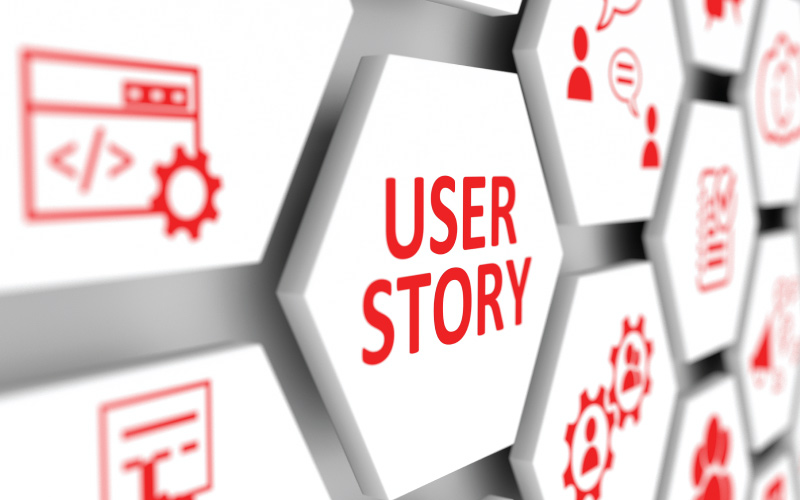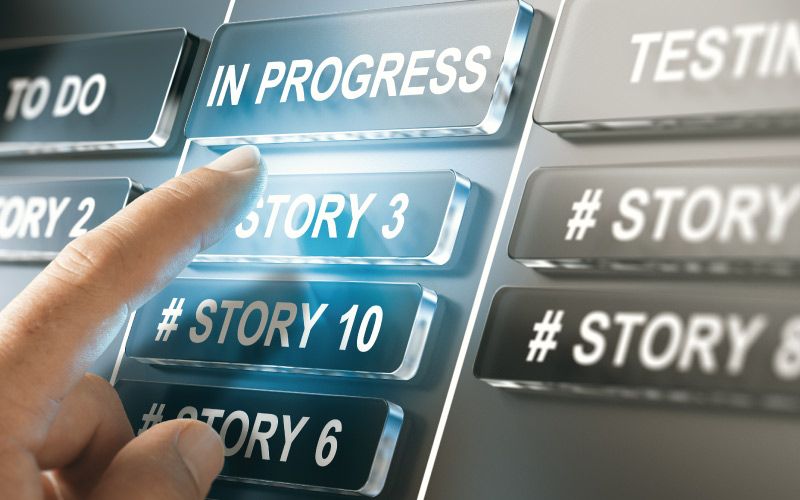Agile User Stories In Project Management 101: A Beginner's Guide

The most effective method for implementing or adopting any methodology or framework is to first understand it thoroughly. The same can be said for agile methodology . Understanding the agile framework and its components is critical for perfecting the implementation of agile practices across the organization.
User story is one such fundamental component of the agile framework. It assists the development team, as well as other agile teams, in understanding what they are building, why they are building it, and what value it will create.
In this blog, we will discuss how to write user stories as well as some user story examples. But, before we get there, let's look at the fundamentals.
What is an Agile User Story?
A user story is the smallest unit of work in the agile project development process. It describes the product, feature, or requirement from the users' perspective. Simply put, a user story is a written description, usually in a few sentences, of a specific user's need and a way to meet it.
It is typically written in clear and simple language so that those working on that feature or project can better understand the user's requirements. Based on the user story information, the agile development team assesses the problem's complexity and estimates the time required to build the feature or product. Nonetheless, each story typically lasts two to four weeks.
In a nutshell, user stories are the foundation of a large agile framework that aims to articulate how a piece of work will provide a specific value to the customer. Some of the major benefits of agile user stories are:
- The user stories help to keep the focus on the user
- It also helps determine the nature and level of possible collaboration between two teams
- User stories contribute to increased efficiency
- User stories also promote innovation in the workplace
3 'C's of a User Story
Ron Jeffris proposed the 3C model for user stories in 2001, where the three Cs stand for Card, Conversation, and Confirmation.
Card: In a user story, a card serves as a placeholder for a conversation. User stories are written on either physical or electronic cards. The cards are sorted by development priority and can be moved independently. When a requirement is no longer required, the card is discarded or 'ripped off.'
Conversation: The second C in 3C stands for 'conversation'. The existence of a card represents the team's commitment in discussing the user's need and the work to be done in a specific time frame or sprint. The purpose of the conversations is to discuss ideas and share knowledge.
Confirmation: The third and final C in 3C stands for 'confirmation'. The user story is not considered complete until it is marked as 'Done.' This concept of confirmation keeps unfinished work from escaping the development team.
User Story Template: Role, Action, Benefit

The user story format is a very simple description of a user issue/expectation that outlines the 'Who', 'What', and 'Why' of that problem or requirement. The typical user story format looks like this:
"As [Role], I want to [Action], so that I can [Benefit]."
The product owner will fill in the blanks with the role, the action they want to take, and the benefits resulting from that action.
User Story Examples
Here are some examples of user stories:
Example 1: A university student
"As a college student, I need to know my fee for this semester so that I can pay for it."
Example 2: A registered user
"As a registered website user, I'd like to be able to leave comments on blog posts so that I can share my feedback."
Example 3: An e-commerce buyer
"As an e-commerce buyer, I want to be able to see my previous purchases so that I can make better purchasing decisions."
These are some examples of user stories. As you can see, each has a persona (e.g., college student, buyer), an action (e.g., know my fees, view previous purchases), and a benefit (e.g., pay the amount, make a better purchase decision).
Let us now understand how to write user stories.
Steps to write User Stories in Agile
Writing user stories will be a breeze if you follow the tips listed here.
Step 1: Keep the user in the center
Always write user stories from the user's perspective. Put yourself in the user's shoes to understand the mindset and actions. You can do this by conducting surveys, collecting user feedback, visiting online forums, and so on.
Step 2: Outline the acceptance criteria
The story is marked 'Done' only when it is considered completed. However, you must first define the set of criteria that must be met for your user story to be marked as 'Done'.
Step 3: Create tasks and subtasks
Outlining tasks and subtasks is the third step in writing user stories. Split your user story into small, manageable tasks. If the requirement is more complex, break it down into subtasks. Set the timeline for completing the tasks besides deciding who will work on them.
Step 4: Create a story map
Story mapping is the fourth step in the process. User story mapping is a creative visualization showing how a customer will likely interact with your product or service. Define the sequential steps for each user story.
Step 5: Give heed to feedback
The final step is to talk to your users and get their feedback. Find out what users like and dislike about the product. In addition, crowdsource the feedback on how those issues should be addressed. Later, incorporate this feedback into your user story.
The INVEST Principle
So you now have a basic understanding of how to write user stories. However, if you want to make these stories more effective, follow the INVEST principle or agile development mnemonic as explained below:
| Letter | Meaning | Description |
|---|---|---|
| I | Independent | Each user story should be self-contained and unique from the others. |
| N | Negotiable | User stories must be adaptable and leave room for discussion between customers and product owners. |
| V | Valuable | Each user story must provide value to the stakeholders. If you cannot find any value, the story should not be marked "Done." |
| E | Estimable | You must always be able to estimate the size of a user story as well as its completion time. |
| S | Small | A user story should be small enough to be finished in a sprint. Remember that small stories help you achieve more accurate results than large stories. |
| T | Testable | The user story and description must contain all the information required for test development. |
Make sure the user story you wrote meets all of the INVEST criteria in order to be both efficient and easy to understand. However, if it does not comply with the INVEST principles, it should be removed from the epic.
Conclusion
Visit our resources to learn more about the Agile framework, agile methodology, and agile manifesto. Talk with our experts about implementing agile practices in your organization.
FAQs - User Story
What are the three Cs of a user story?
The three Cs in the user story stand for Card, Conversation, and Confirmation.
Who writes the user story in a scrum?
In scrum, the user story is usually written by the product owner.
What is included in the user story?
A typical user story is a brief description of the user's problem/need, the actions that must be taken, and the benefit that the feature can provide.
What does the Agile mnemonic INVEST stand for?
INVEST stands for independent, negotiable, valuable, estimable, small, and testable.
Thanks for subscribing to our latest blogs, thought leadership and other product updates!
Read our Privacy Notice to know more. You can opt-out of all communications anytime.
